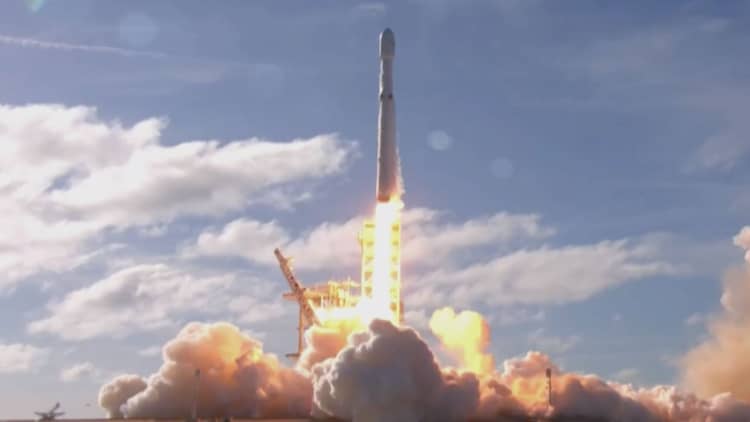
One surprising sensation defines what it feels like to stand just three miles from one of the biggest rocket launches of all time:
Silence.
And that's how it was with SpaceX's Falcon Heavy.
We stood atop the roof of NBC's media building, three stories up from the ground and cooked by the sun as delays pushed back the targeted launch time. Originally slated for 1:30 p.m. EST, SpaceX bumped it repeatedly until the launch was set to happen just before 4 p.m. Wind conditions were not ideal, officials explained, and worries began to creep in that the launch would be pushed to the next day.
Hanging over us while we were waiting was the real possibility that this rocket could blow up. Even the night before, SpaceX CEO Elon Musk said he would consider it a success if Falcon Heavy didn't damage the launch pad. If it were to actually explode, we might have to move – and fast – to avoid flying debris.
But then the wind turned: With 15 minutes until the Air Force's designated launch window would close, SpaceX decided to begin the final countdown.
Ten seconds before the launch, the reporters gathered around NASA's Kennedy Space Center fell silent. All eyes were glued to the gleaming white, 23-story-tall rocket in the distance as the clock counted lower.
Six seconds to launch, a plume of smoke burst from the base of the rocket, billowing out from the pad as kerosene fuel powered up the motors.
Four seconds. The plume of smoke tripled in size, as all 27 of Falcon Heavy's engines came to life.
Zero. The strongback arm holding the rocket vertical slipped away. In silence Falcon Heavy slowly rose, breathing fire from its three cores, the flames pouring from its base nearly too bright to watch. Yet, as Musk's rocket began to pick up speed, the only initial sound came from the cheers and whistles of the thousands gathered at Kennedy.
And then, with Falcon Heavy streaking away, 20 seconds after liftoff, the ground began to shake.
The lens on our video camera rattled as it captured the event live on television. We felt the roar more than we heard it, the sound drowning out the crowds and hitting us in the chest as if we were leaning into a rock concert loudspeaker.
Falcon Heavy flew out of sight, becoming the most powerful commercial rocket in history.
Silence returned across the area as onlookers strained to follow the rocket's next stage: the ambitious return of the two side boosters that SpaceX hoped to land a few miles south at Cape Canaveral Air Force Station.
Within minutes, they appear: two bright lights, ripping back through the Earth's atmosphere. The boosters blinked side by side for a few seconds, winding their way to the ground in a dance of aerial acrobatics. Again, silence, as the crowd waited for the results.
'BOOM BA-BOOM, BOOM BA-BOOM!'
As if skeet shooters fired their 12-gauges in symphonic harmony, four sonic booms punched through the air. SpaceX had warned these would occur if the test went this well – booms that may be heard across six central Florida counties.
It seemed like science fiction as each booster's engine fired one last time before gliding neatly behind the treetops to land on concrete pads.
We would find out later that the third booster, which SpaceX also hoped to recover, would not make it. Some 200 miles away, out in the Atlantic Ocean, the center core slammed into the water at 300 mph, missing its mark on the company's drone ship.
But Falcon Heavy's test payload was well on its way to space: Musk's midnight cherry Tesla Roadster floated serenely in orbit, its "Starman" mannequin pilot marking the first Falcon Heavy payload delivered to space. By late Tuesday night, that payload would be making its way toward the asteroid belt, for what Musk hopes will ultimately be an elliptical orbit around the sun.
Now is the part where we admit that Falcon Heavy's launch was the first either of us have experienced in person.
We have watched hundreds of launches online, taking in the excitement through all the camera angles available and listening to the crackle of the rocket's motors through headphones. But absolutely nothing prepared us for what it's like to physically experience a launch. It shook us to our core, rattling every bone in our bodies.
Everyone we met in Florida, many of whom have seen dozens of launches, told us, "Well, you sure picked a good one." They also said they hadn't seen the Space Coast this excited and this packed with onlookers since the days of Apollo.
At a post-launch news conference, Musk even said he wants a space race, saying that "space races are fun."
WATCH: SpaceX launches its most powerful rocket ever




